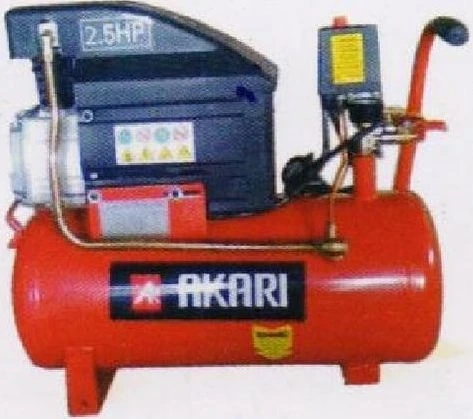What are air compressors?
Many are unaware that scuba divers’ diving gear includes air compressors. Yes, there are many different environments where air compressors are used, and the uses are just as varied. An air compressor is a pneumatic tool that transforms power from an engine, such as an electric motor, diesel engine, or gasoline engine, into potential energy stored in pressurized air (i.e., compressed air). An air compressor raises the pressure in a storage tank by using several techniques to push more and more air into the container.
Akari 1.5 hp 30 L Air Compressor Tank AK10030
Functioning of Air Compressors
Air compressors can be used for a range of tasks, including nail gun operation and tyre inflation. Let’s find out how to locate a compressor that can fulfill our tasks.
The most popular versions for household usage are single-stage, piston-type air compressor tanks, which are helpful for various tasks around the house or workshop. The piston compresses the air and forces it into a storage tank. The air pressure increases as the piston pushes in more air. The compressor switches off when the pressure reaches a certain point. The compressor restarts when we utilize the compressed air to operate a tool in order to restore the air pressure.
Two pistons are used in two-stage compressors. The first piston compresses the air, delivering it to the second piston, which further compresses it and sends it to the tank, through a check valve. These compressors are typically heavy-duty, commercial types that have higher PSI levels and can provide a larger amount of air. They are suitable options for shops that need to run many tools continuously.
PowerHouse 1.5 HP Air Compressor
Types of air compressors
There are three main types of air compressors: consumer-standard, professional-standard, and industrial-standard.
Consumer standard
The term "pancake" or "single-stage" model accurately describes consumer-grade air compressors. In addition to using low-load air tools like staplers and brand guns for domestic duties like inflating tyres and inflatable items, they may also be utilized for other purposes.
Professional standard
Professional-grade air compressors offer more power and air that is more intensely compressed. They could be rotary screw types or two-stage reciprocating ones, and they can offer greater power to run numerous air tools simultaneously with intermittent use.
Industrial standard
The main power source on an oil rig or the workhorse of a manufacturing facility will be industrial-grade air compressors. They can withstand fluctuating spikes in demand that are usual in large production plants and are made to supply a constant flow of compressed air for extended periods of time. These compressors can be customized to the particular environment to increase performance, energy efficiency, and dependability. They are constructed with high-quality components.
Orbit 24 L 2 HP Oil compressor
How to choose the right air compressor?
1. We should consider the specifications of the machinery we will be operating.
Are we intending to use the compressor to just inflate a tyre or to power pneumatic tools or machinery? If we are going to be using tools that need a high flow, we should probably get a compressor with a tank. If we only want to use a portable compressor for airbrushing or filling tyres, we might wish to get one without a tank. The tankless type will run continuously because there is no tank to hold the compressed air, but this normally isn\'t a problem because they are often relatively small and make little noise.
2. Recognize the various compressor kinds.
Air compressors come in two basic varieties: reciprocating and rotary screws. The reciprocating piston kind is the one we\'ll most frequently see for sale. It has a one-way valve on top of the moving piston and a cylinder with an up-and-down moving piston. A dual-piston configuration is used by some air compressors to provide higher flow and pressure. The rotary screw air compressor tank is the alternative type, these are made for continuous usage and are frequently used in industrial settings.
3. Look at the air compressor\'s horsepower (HP).
An air compressor\'s typical horsepower range is 1.5 to 6.5 HP. There are air compressors with higher HP capacities, but they are typically only used in industrial settings and provide much higher psi. Small-scale applications won\'t need as much horsepower as heavy-duty applications. Although it\'s important to consider horsepower when choosing an air compressor, it shouldn\'t be the only factor. If we can find one, a CFM rating—or cubic feet per minute—will be more useful.
4. Consider examining Cubic Feet per Minute (CFM.)
A volumetric flow metric is CFM. The tricky aspect is that CFM differs based on the compressor\'s psi, making it difficult to just combine the CFMs of two tools with varying psi, which is what you need to be able to accomplish.
5. Think about the power supply.
A drive system with an electric motor is an option if we want to always be close to an outlet. Although the majority of electric air compressor tanks use 110V, some larger models use 240V. As an alternative, we should think about choices for mobile air compressors. Mobile air compressors can employ diesel or gasoline engines, the built-in engine of the vehicle or a hydraulic port.
Conclusion
The demand for compressed air in the industrial sector is rising along with the level of automation across all industries, and this dependence will only get stronger in the future. Take a look at Industry Buying, for the very best air compressors, their product description as well as their price list.
0



